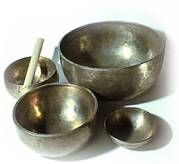 A singing bowl is an instrument that is used in many Asian cultures as a call to worship, a meditative accompaniment to prayer, a healing device, and a tonal kind of "incense" that lifts prayers up to heaven. I’ve used singing bowls as a wordless call to worship during Masses in Lent and Advent and at other liturgies. It’s a great way to set the tone for a celebration.
A singing bowl is an instrument that is used in many Asian cultures as a call to worship, a meditative accompaniment to prayer, a healing device, and a tonal kind of "incense" that lifts prayers up to heaven. I’ve used singing bowls as a wordless call to worship during Masses in Lent and Advent and at other liturgies. It’s a great way to set the tone for a celebration.You can buy singing bowls from many places, even online. But the best place I’ve found is in person at the Berkeley Himalayan Fair. This fair happens once a year and is a great source for singing bowls and colorful fabrics. You'll find lots of vendors each selling tons of singing bowls of all shapes, sizes, and sounds.
If you're nowhere near Berkeley or Mountain View, just do an online search for "singing bowls" and you'll find thousands of singing bowl vendors with both online and tradition brick-and-mortar storefronts. You can also look for them at many music stores that sell ethnic instruments, yoga centers, and businesses that specialize in Asian goods.
- Hold your hand open and flat, and balance your bowl on your palm. Try not to let your fingers touch the sides of the bowl since this will deaden the sound.
- Feel its weight. Bowls of thinner material usually sound more metalic than thicker more solid-weighted bowls.
- Using a wooden stick, strike the bowl's side once just below the lip. Keep your stick parallel to the ground as you hit the bowl.
- Start with a soft gentle strike. Then try a medium force. Then finally, give your bowl a good strong hit. Let the tone die down each time before hitting the bowl to test how long the bowl sounds with each type of strike.
- Finally, make your bowl sing. Holding the bowl in your palm, gently strike the bowl with your stick. Then, as the bowl is ringing, hold the stick upside down at a 45 degree angle. Place the stick against the outside edge of the bowl's rim, and rub the stick slowly around the circumference of the rim using even pressure all the way around. This motion is similar to rubbing your finger around the lip of a wine glass to make it vibrate. If you're bowl starts to "chatter", slow down your motion. You'll probably need to practice this a bit. Some bowls are harder to make sing than others. Each bowl will be different.
Tones will vary in pitch depending on the size of your bowl. Listen for a clarity in the bowl's tone. Some bowls will have a "buzzing" sound; some will sound "tinny"; some bowls will make several "notes" simultaneously. This will sound discordant. (Don't get this sound mixed up with the pleasant natural harmonics that occur with any tone.) Most likely you will want a bowl that makes a clear "pure" single tone that doesn't fade too quickly. If you don't get a clear sound, make sure you are not dampening the sound too much with your hand and that you are striking the bowl solidly just beneath the lip. If you still don't get the quality of sound you want, find another bowl.
Before you make a final decision, think about how you plan to use your bowl. If you want to use it for liturgies in a large church, you will probably need a larger bowl to fill the space. Different kinds of mallets will also give you a different sound. A mallet with a crack will give you an imperfect sound. A mallet wrapped with felt gives a less harsh sound but might also be too quiet for your needs. You can often ask the vendor for a different mallet that goes better with your bowl. Also note that the small cushions that often accompany the bowls are not always necessary to use. Only bowls that you cannot hold comfortably in your hand will need a cushion.
An average-sized bowl (6-9 inches in diameter) of good quality can run you about $75-$100. The stick is always included in the price. Cushions may or may not be included.